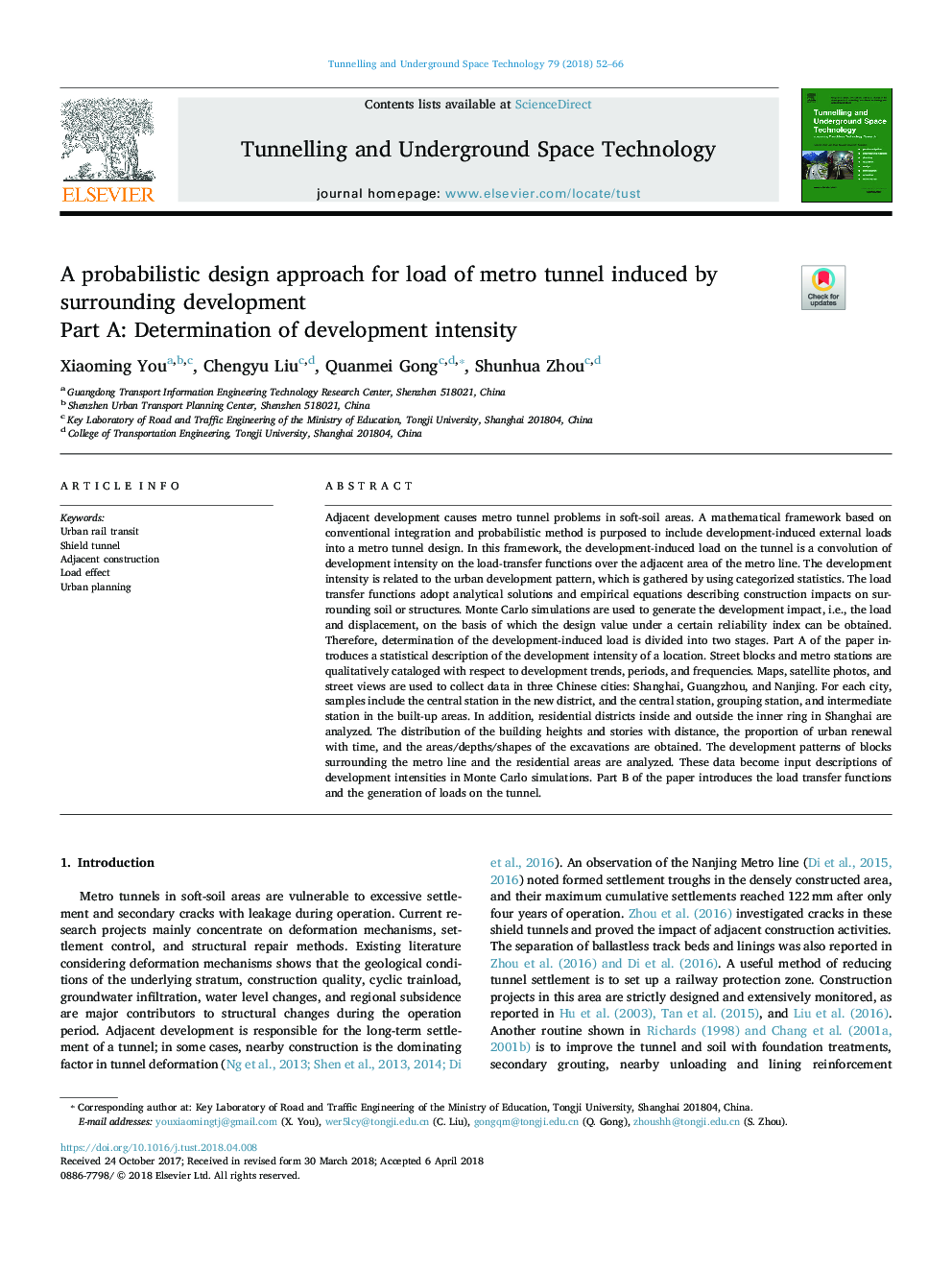| کد مقاله | کد نشریه | سال انتشار | مقاله انگلیسی | نسخه تمام متن |
|---|---|---|---|---|
| 6782189 | 1432267 | 2018 | 15 صفحه PDF | دانلود رایگان |
عنوان انگلیسی مقاله ISI
A probabilistic design approach for load of metro tunnel induced by surrounding development
ترجمه فارسی عنوان
رویکرد طراحی احتمالی برای بار تونل مترو که ناشی از توسعه اطراف آن است
دانلود مقاله + سفارش ترجمه
دانلود مقاله ISI انگلیسی
رایگان برای ایرانیان
کلمات کلیدی
حمل و نقل راه آهن شهری، تونل سپر، ساخت و ساز مجاور، اثر بار، برنامه ریزی شهری،
ترجمه چکیده
توسعه مجاور باعث مشکلات تونل مترو در مناطق نرم خاک شده است. چارچوب ریاضی بر مبنای یکپارچگی معمول و روش احتمالاتی، هدف قرار دادن بارهای خارجی ناشی از توسعه به یک طراحی تونل مترو است. در این چارچوب، بار ناشی از توسعه در تونل، تلفیقی از شدت توسعه در توابع انتقال بار بیش از منطقه مجاور خط مترو است. شدت توسعه مربوط به الگوی توسعه شهری است که با استفاده از آمار طبقه بندی شده جمع آوری می شود. توابع انتقال بار، راه حل های تحلیلی و معادلات تجربی را ارائه می دهند که اثرات ساخت و ساز بر روی خاک یا سازه های اطراف را توصیف می کنند. شبیه سازی مونت کارلو برای تولید تأثیر توسعه، یعنی بار و جابجایی، بر اساس آن، ارزش طراحی را تحت یک شاخص اطمینان مشخص می توان یافت. بنابراین تعیین بار ناشی از توسعه به دو مرحله تقسیم می شود. قسمت اول مقاله، یک توصیف آماری از شدت توسعه مکان را معرفی می کند. بلوک های خیابانی و ایستگاه های مترو با توجه به روند توسعه، دوره ها و فرکانس ها به صورت کیفی فهرست شده است. نقشه ها، عکس های ماهواره ای و نمای خیابان ها برای جمع آوری داده ها در سه شهر چینی، شانگهای، گوانگژو و نانجینگ استفاده می شود. برای هر شهر نمونه شامل ایستگاه مرکزی در منطقه جدید و ایستگاه مرکزی، ایستگاه گروهی و ایستگاه بینابینی در مناطق شهری است. علاوه بر این، مناطق مسکونی داخل و خارج از حلقه داخلی در شانگهای تجزیه و تحلیل می شود. توزیع ارتفاع ساختمان و داستان با فاصله، نسبت بازسازی شهری با زمان و مناطق / عمق / شکل حفاری ها به دست می آید. الگوهای توسعه بلوک های اطراف خط مترو و مناطق مسکونی تجزیه و تحلیل می شود. این داده ها توصیف ورودی شدت توسعه در شبیه سازی های مونت کارلو می شود. قسمت ب مقاله، توابع انتقال بار و تولید بار در تونل را معرفی می کند.
موضوعات مرتبط
مهندسی و علوم پایه
علوم زمین و سیارات
مهندسی ژئوتکنیک و زمین شناسی مهندسی
چکیده انگلیسی
Adjacent development causes metro tunnel problems in soft-soil areas. A mathematical framework based on conventional integration and probabilistic method is purposed to include development-induced external loads into a metro tunnel design. In this framework, the development-induced load on the tunnel is a convolution of development intensity on the load-transfer functions over the adjacent area of the metro line. The development intensity is related to the urban development pattern, which is gathered by using categorized statistics. The load transfer functions adopt analytical solutions and empirical equations describing construction impacts on surrounding soil or structures. Monte Carlo simulations are used to generate the development impact, i.e., the load and displacement, on the basis of which the design value under a certain reliability index can be obtained. Therefore, determination of the development-induced load is divided into two stages. Part A of the paper introduces a statistical description of the development intensity of a location. Street blocks and metro stations are qualitatively cataloged with respect to development trends, periods, and frequencies. Maps, satellite photos, and street views are used to collect data in three Chinese cities: Shanghai, Guangzhou, and Nanjing. For each city, samples include the central station in the new district, and the central station, grouping station, and intermediate station in the built-up areas. In addition, residential districts inside and outside the inner ring in Shanghai are analyzed. The distribution of the building heights and stories with distance, the proportion of urban renewal with time, and the areas/depths/shapes of the excavations are obtained. The development patterns of blocks surrounding the metro line and the residential areas are analyzed. These data become input descriptions of development intensities in Monte Carlo simulations. Part B of the paper introduces the load transfer functions and the generation of loads on the tunnel.
ناشر
Database: Elsevier - ScienceDirect (ساینس دایرکت)
Journal: Tunnelling and Underground Space Technology - Volume 79, September 2018, Pages 52-66
Journal: Tunnelling and Underground Space Technology - Volume 79, September 2018, Pages 52-66
نویسندگان
Xiaoming You, Chengyu Liu, Quanmei Gong, Shunhua Zhou,
